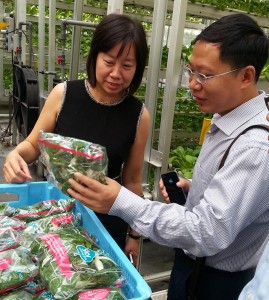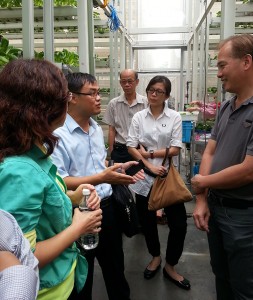Mr Ye Guoyun, a student from the MPAM Class of 2014 shares his experience
 As arranged by MPAM programme office, we were honoured to be able to visit the Sky Greens farm on 29 August 2014. We met Mr Jack Ng (CEO, Sky Greens) and Mdm Wong Geok Chwee (COO, Sky Greens) and were introduced to the establishment, operation, development and collaboration partners for the farm through a presentation. We visited several sectors of the farm and had also explored future possibilities of collaboration. Together with us at the visit were staff from MPAM programme office and officers from Agri-Food & Veterinary Authority (AVA) of Singapore.
As arranged by MPAM programme office, we were honoured to be able to visit the Sky Greens farm on 29 August 2014. We met Mr Jack Ng (CEO, Sky Greens) and Mdm Wong Geok Chwee (COO, Sky Greens) and were introduced to the establishment, operation, development and collaboration partners for the farm through a presentation. We visited several sectors of the farm and had also explored future possibilities of collaboration. Together with us at the visit were staff from MPAM programme office and officers from Agri-Food & Veterinary Authority (AVA) of Singapore.
We were received by Mr Jack Ng and his colleagues upon arrival at the Sky Greens. After some formalities, we were given a presentation at the conference room about the history of company and collaborative partners, collaboration projects and prospects of the company. We were impressed by the idea of new farming model and were eager to visit the vertical farming model and commercialized operation. Upon arrival at the farming area, we saw a large structure erected and covered with transparent plastic sheets and gauze. It is a farming model constructed with the concept of multi-story carpark. The large shed provides car park at the lower part and at the same time, growing vegetables in the structure on the top and sides. The structure acts as a cooling sheds for the cars and greenery coverage, while the vegetables bring about extra economic benefits. The concept could be further developed into a home leisure agriculture model which combines the agriculture and home lifestyle, suitable for those who wish to farm but do not have the land space.
 We have also seen another farming model where the shed was built on a pond. This design is suitable for those areas where land areas are scarce. The shed floats on the pond, with fish in the pond and vegetable grown in the sheds. Irrigation was done by drawing water from the pond, which saves energy and resources. Floating plants in the pond serve as the fertilizer and the fish keep watch on the quality of water. That arrangement has its economic benefits. The concept coincides with our thinking model of ecological agriculture.
We have also seen another farming model where the shed was built on a pond. This design is suitable for those areas where land areas are scarce. The shed floats on the pond, with fish in the pond and vegetable grown in the sheds. Irrigation was done by drawing water from the pond, which saves energy and resources. Floating plants in the pond serve as the fertilizer and the fish keep watch on the quality of water. That arrangement has its economic benefits. The concept coincides with our thinking model of ecological agriculture.
Other than the farming model, there are about 300 vegetable sheds in operation. Six common varieties of vegetables were produced. The shed we visited grows Nai baicai and Xiaobaicai. The temperature in the shed was cool and pleasant. Each A-shape structure measures about 9 m tall. On the structure, there were more than ten rows of potted vegetables on each row. Each row of vegetables was rotated very slowly through conveyor system, from the bottom where irrigation was done and to the top, for the sunlight. Each cycle will take about 16 hours, each row of vegetables was being rotated around akin to a triangular sky-flyer system. We discussed with Mr Ng about breeding, soil, irrigation and fertilizing. He deliberated that each plant should receive sufficient nutrition and the per unit planting area investment for soil, irrigation, fertilizer and energy consumption are very low compared with tradition planting method, and could achieve very high utilization rate. The technical staff is also able to customize the proportion of nutrition according to different type of vegetables. The resulted output is vegetables with higher nutrition and taste better than those planted with tradition method. The transparent shed also shields away the pests and thus there is no need to apply any pesticides. Mr Ng showed us the well-grown vegetables and said: “We farm with the principle of happy planting, which means they will grow better with happy planting.”
During our visit, the workers were harvesting the vegetables. The conveyor brings the row of vegetables to a suitable height for harvesting. Vegetables were cut, weighed and packaged. In a short while, the trolleys were packed with loads of packets of vegetable. According to Mr Ng, those packed vegetables are normally kept in the cold room for a while before being sent directly for sale in the supermarkets. In our direct assessment, the whole process of vertical farm, the number of stages were lesser, using less manpower and the works are less stressful than traditional method. They do not need to expose themselves to hot sun or cold wind, and do not even need to bend down while working.
We were impressed throughout the visit. The farming concept of young people in China nowadays has been changed. Many people chose not to involve in farming and thus many of the land and the labour force were left unused, and as a result we are facing a declining agricultural output. Such problem is also more severe in the area where I worked. It will be good if we could introduce such innovative ideas and solution to those areas so that it will eradicate our problems effectively.